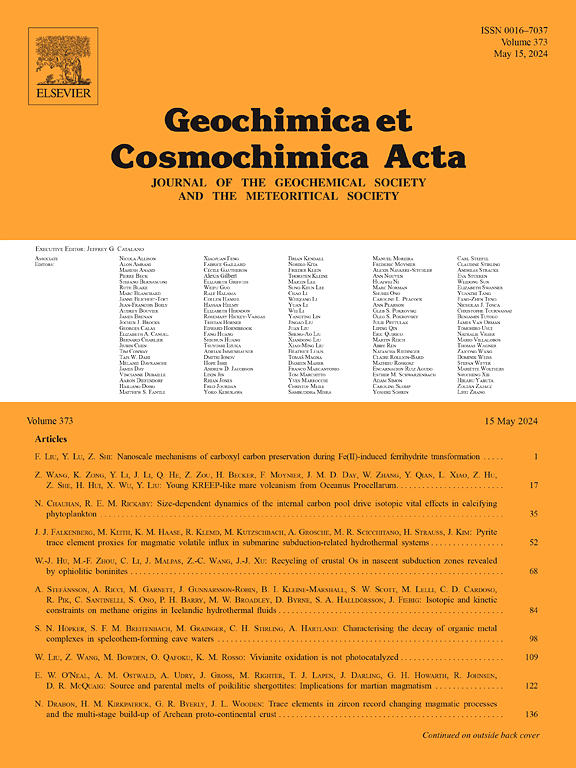在地球前生物条件下利用醛和氨一步合成非典核糖核苷及其前体
IF 4.5
1区 地球科学
Q1 GEOCHEMISTRY & GEOPHYSICS
引用次数: 0
摘要
形成可保存基因信息并可作为催化剂的聚合物是生命起源的关键一步。催化 RNA(即核糖核酸酶)的发现支持了一种假设,即在地球生命的早期阶段,RNA 可能就具有这些功能。有鉴于此,RNA 单体(即核糖核苷酸)的自发形成及其在哈代地球上的聚合是生命起源的必要步骤。以前的实验研究了核糖核苷酸及其成分形成的化学反应。这些工作揭示了形成生物核糖核苷酸(即典型核糖核苷酸)所需的分子。从地球化学的角度来看,大量存在的活性分子会自发地相互反应,提供丰富的产物。据推测,醛和氨这两种活性分子在哈代地球上的存在量相当大。然而,人们对核苷酸及其成分是否在前生物条件下由这些分子形成知之甚少。我们研究了醛和氨的碱性水溶液的孵育产物。产物溶液中含有糖(包括核糖)、各种咪唑衍生物和核糖基咪唑(即咪唑核糖核苷)。核糖基咪唑是通过核糖基胺形成的,这揭示了前生物核糖核苷合成的新反应途径。然后,咪唑核糖核苷通过与磷酸盐的简单干化反应被磷酸化成咪唑核糖核苷酸。硼酸根离子提高了这些核苷和核苷酸的反应产率。由于在前生物地球上可以获得所有反应物,而且反应是自发进行的,因此咪唑核糖核苷酸可能在前生物环境中积累。本反应的实验简易性表明,在前生物地球上,咪唑类比典型核碱基更为丰富。这进一步意味着,前生物寡核苷酸除了含有典型的核碱基外,还含有咪唑碱基。硼酸盐提高了反应产率,这表明富含硼酸盐的环境有利于非经典核苷酸和核苷酸的形成和积累。这种环境可能促进了哈代地球上原始核糖核酸的形成。本文章由计算机程序翻译,如有差异,请以英文原文为准。
One-pot synthesis of non-canonical ribonucleosides and their precursors from aldehydes and ammonia under prebiotic Earth conditions
The formation of polymers that can hold gene information and work as catalysts is a crucial step for the origin of life. The discovery of catalytic RNA (i.e., ribozyme) supports the hypothesis that RNA might have served these functions at the early stage of life on the Earth. Given this, the spontaneous formation of RNA monomers (i.e., ribonucleotides) and their polymerization on Hadean Earth are essential steps for the origin of life. Previous experiments have investigated the chemical reactions that allow the formation of ribonucleotides and their components. These works have revealed the required molecules to form biological ribonucleotides (i.e., canonical ribonucleotides). Based on geochemical perspectives, abundantly available reactive molecules spontaneously react with each other to provide abundant products. Aldehydes and ammonia are reactive molecules assumed to have been present in considerable amounts on Hadean Earth. However, little is understood about whether or not nucleotides and their components were formed from these molecules under prebiotic conditions. We investigated the incubation products of alkaline aqueous solutions of aldehydes and ammonia. The product solution contained sugars (including ribose), various imidazole derivatives, and ribosyl imidazole (i.e., imidazole ribonucleoside). Ribosyl imidazole is formed via ribosyl amine, which reveals a new reaction pathway for prebiotic ribonucleoside synthesis. The imidazole ribonucleoside was then phosphorylated to imidazole ribonucleotide via a simple dry-down reaction with phosphate. Borate ion improved the reaction yields of these nucleosides and nucleotides. Because all the reactants were available on prebiotic Earth and the reactions progressed spontaneously, imidazole ribonucleotides could have accumulated in prebiotic environments. The experimental simplicity of the present reaction suggests that imidazoles were more abundant than canonical nucleobases on the prebiotic Earth. This further implies that prebiotic oligonucleotides contained imidazole bases in addition to the canonical nucleobases. The improvement of the reaction yields by borate indicates that borate-rich environments were conducive places for the formation and accumulation of non-canonical nucleosides and nucleotides. Such environments could have facilitated the formation of primordial ribonucleic acids on Hadean Earth.
求助全文
通过发布文献求助,成功后即可免费获取论文全文。
去求助
来源期刊

Geochimica et Cosmochimica Acta
地学-地球化学与地球物理
CiteScore
9.60
自引率
14.00%
发文量
437
审稿时长
6 months
期刊介绍:
Geochimica et Cosmochimica Acta publishes research papers in a wide range of subjects in terrestrial geochemistry, meteoritics, and planetary geochemistry. The scope of the journal includes:
1). Physical chemistry of gases, aqueous solutions, glasses, and crystalline solids
2). Igneous and metamorphic petrology
3). Chemical processes in the atmosphere, hydrosphere, biosphere, and lithosphere of the Earth
4). Organic geochemistry
5). Isotope geochemistry
6). Meteoritics and meteorite impacts
7). Lunar science; and
8). Planetary geochemistry.
 求助内容:
求助内容: 应助结果提醒方式:
应助结果提醒方式:


